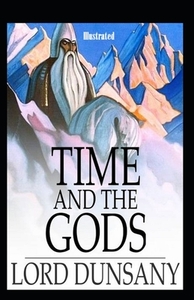Take a photo of a barcode or cover
challenging
reflective
slow-paced
Plot or Character Driven:
Character
Strong character development:
Complicated
Loveable characters:
Complicated
Diverse cast of characters:
No
Flaws of characters a main focus:
Complicated
Definitely a harder read, I did understand most of it though. I liked the descriptions as well as the concepts of it all. I have read some of this authors works before and found them decent. I have another of Lord Dunsanys books on my shelf I have yet to read so, hopefully it wont drag on as long as this one did. This book took me a little longer with alot of the chapters, but im done now.
It's simply too strange a book for me to enjoy. I couldn't get through a single page without serious effort.
Paradoxical tales of the gods on a world out of dreams.
These were strange, oddly moving little myths of an imaginary world. Oddly moving because they were so horrific and twisted, with people longing to follow gods that laughed at their cruel deaths, that sort of thing. I got the feeling that the author hated his own creations.
The openings of each of the stories was so offputting that I'd finish one and have to stop and work myself up to reading another. And the style was o thou fake antiquations to the extreme.
Fascinating book, hard to read.
Recommended if you're looking for root stories to things like The Sandman by Neil Gaiman, or The Wicked and The Divine, or like all things meta fantasy and don't mind digging for gold.
These were strange, oddly moving little myths of an imaginary world. Oddly moving because they were so horrific and twisted, with people longing to follow gods that laughed at their cruel deaths, that sort of thing. I got the feeling that the author hated his own creations.
The openings of each of the stories was so offputting that I'd finish one and have to stop and work myself up to reading another. And the style was o thou fake antiquations to the extreme.
Fascinating book, hard to read.
Recommended if you're looking for root stories to things like The Sandman by Neil Gaiman, or The Wicked and The Divine, or like all things meta fantasy and don't mind digging for gold.
reflective
slow-paced
One has to respect Dunsany for the long shadow he casts over all of modern fantasy, but even the most generous reviewer would have to say this collection is uneven.
A dreamy, meandering tale of time and the gods . . .
Not Lord Dunsany's best work, in my opinion, but the dreamlike quality of his prose imagery and his gorgeous, purple language is worth reading, even if the story itself does meander quite a bit. One can definitely see the influence he had on Lovecraft's dream cycle!
Not Lord Dunsany's best work, in my opinion, but the dreamlike quality of his prose imagery and his gorgeous, purple language is worth reading, even if the story itself does meander quite a bit. One can definitely see the influence he had on Lovecraft's dream cycle!
Time and the Gods, first published in 1906, was Lord Dunsany's second book. It follows on from The Gods of Pegāna with somewhat the same style, although only the first few stories mentions Pegāna and some of its gods: "The Coming of the Sea" speaks of Slid, the god of the sea, as does "A Legend of the Dawn," which refers also to Pegāna's Limpang Tung, the Lord of Music; "The Vengeance of Men," "When the Gods Slept," and "The King That Was Not" all mention Pegāna, and the latter talks of Mung, the god of death. Many of the other stories speak of the Old Gods, but none refers specifically to Pegāna and its gods.
Time and the Gods contains 19 short stories in Part I and a novella in Part II, "The Journey of the King." While The Gods of Pegāna reads like a kind of fantastical scripture, establishing a new pantheon, Time and the Gods opens out to speak more of kings, and prophets, and great journeys, and such. Dunsany's incomparable imagination is unfolding and developing in this book, as it will continue to throughout his work, gradually to encompass more elements of "the fields we know," to use a Dunsanian phrase. Time and the Gods, however, is still fully fantastic, with no hint yet of our everyday world.
Time and the Gods contains a further ten lovely plates by Dunsany's illustrator, Sidney H. Sime, which are the perfect accompaniment to Dunsany's whimsical and melancholy stories. The cover reproduces THE DIRGE OF SHIMONO KANI, from Chapter V of "The Journey of the King." Shimono Káni is playing a harp and to me his features look much like those of the young Dunsany. Did Sime use Dunsany as a model for this drawing? Dunsany writes,
Time and the Gods contains 19 short stories in Part I and a novella in Part II, "The Journey of the King." While The Gods of Pegāna reads like a kind of fantastical scripture, establishing a new pantheon, Time and the Gods opens out to speak more of kings, and prophets, and great journeys, and such. Dunsany's incomparable imagination is unfolding and developing in this book, as it will continue to throughout his work, gradually to encompass more elements of "the fields we know," to use a Dunsanian phrase. Time and the Gods, however, is still fully fantastic, with no hint yet of our everyday world.
Time and the Gods contains a further ten lovely plates by Dunsany's illustrator, Sidney H. Sime, which are the perfect accompaniment to Dunsany's whimsical and melancholy stories. The cover reproduces THE DIRGE OF SHIMONO KANI, from Chapter V of "The Journey of the King." Shimono Káni is playing a harp and to me his features look much like those of the young Dunsany. Did Sime use Dunsany as a model for this drawing? Dunsany writes,
One by one in the midst of all the worlds, fell dead the gods of Old, still sighing for the things that might not be, all slain by Their own regrets. Only Shimono Káni, the youngest of the gods, made him a harp out of the heart strings of all the elder gods, and, sitting upon the Path of Stars all in the Midst of Things, played upon the harp a dirge for the gods of Old. And the song told of all vain regrets and of unhappy loves of the gods in the olden time, and of their great deeds that were to adorn the future years. But into the dirge of Shimono Káni came voices crying out of the heart strings of the gods, all sighing still for the things that might not be. And the dirge and the voices crying, go drifting away from the Path of Stars, away from the Midst of Things, till they come twittering among the Worlds, like a great host of birds that are lost by night. And every note is a life, and many notes become caught up among the worlds to be entangled with flesh for a little while before they pass again on their journey to the great Anthem that roars at the End of Time. Shimono Káni hath given a voice to the wind and added a sorrow to the sea. (pp. 141-142)
It seems suitable that this youngest of the gods, Shimono Káni, is the alter-ego of Dunsany himself. Dunsany's writing continues in this same solemn and poetic style through the whole of Time and the Gods.
adventurous
mysterious
medium-paced
Plot or Character Driven:
Plot
Strong character development:
No
Loveable characters:
Complicated
Diverse cast of characters:
Yes
Flaws of characters a main focus:
Yes
challenging
slow-paced
Plot or Character Driven:
Plot
Strong character development:
Complicated
Loveable characters:
Complicated
Diverse cast of characters:
Complicated
Flaws of characters a main focus:
Complicated
challenging
mysterious
slow-paced
Strong character development:
No







